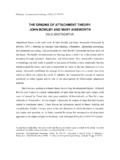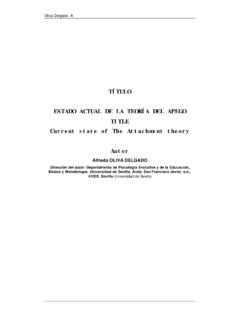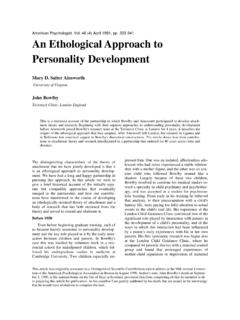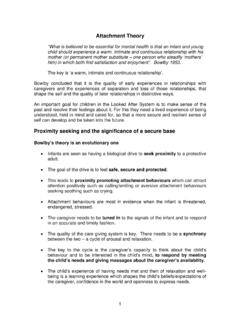Transcription of The Legacy of John Bowlby’s Attachment Theory This …
1 Chapter 9 The Legacy of John bowlby s Attachment Theory Jools Page Introduction This chapter discusses the contribution of John bowlby s more than 50 years of thinking about attachments, separation, relationships and emotional stability. After a brief biography, the chapter considers his well-known, and sometimes controversial, Attachment Theory alongside the work of his collaborators at the time, including James Robertson and Mary Ainsworth. A key focus is Attachment Theory in relation to children in their home and early years environments, and how understanding this Theory is important for early years practitioners to appreciate the lived experiences of children in out of home contexts.
2 The chapter concludes with a consideration of the place of love and loving relationships in contemporary professional practice and the implications of Modern Attachment Theory for early years and childcare practitioners working globally. John bowlby [1907-1990]: A brief biography bowlby (1907 1990) was the son of Sir Anthony bowlby , a London surgeon. After serving briefly as a naval cadet, he read natural sciences and psychology at the University of Cambridge. bowlby worked for a time in a school for boys with psychiatric problems, then trained as a doctor and child psychiatrist, working during the Second World War World as a psychiatrist for the War Office Selection Board.
3 After the war, bowlby was Deputy Director of the Tavistock Clinic in London, a world-renowned centre for child psychiatry and psychotherapy (For further detail see King & Rayner 1993). It was soon after he graduated from Cambridge in 1928 that bowlby began to study separation and anxiety, building on observations of two young boys in a remedial home where he was working (Bretherton 1992; and Cassidy, 2008). From these observations bowlby developed what is now known as Attachment Theory . bowlby disagreed with the philosophies of his former supervisor Melanie Klein, and aligned his ideas more strongly with those of Sigmund Freud, claiming that psychoanalysis must be rooted in children s relationships within their family as well as being supported by solid scientific research (Alsop-Shields and Mohay, 2001) (see Chapter 8).
4 What was the original Attachment Theory ? bowlby s work should be seen in the context of a much broader tradition of interest in infant-caregiver relationships. bowlby s notion of Attachment was significantly prompted by the findings of his early studies in 1944 which had investigated the behaviour of 44 children aged from five to 16 years who had been caught stealing and were referred to the Tavistock clinic for psychological assessment. bowlby s conclusions about the causes of their behaviour were highly criticised because the methods he used were not considered to be rigorous, which he conceded to be the case ( bowlby , 1944a, 1944b).
5 Nevertheless, his early ideas provided an important basis for the later work Influence and collaboration James Robertson was a social worker, and later a psychoanalyst. After the war, he became interested in bowlby s work and, worked as his research assistant at the Tavistock Clinic focusing on the behaviour of children separated from their mothers (Alsop-Shields and Mohay, 2001). bowlby and Robertson concluded that the two boys bowlby had studied - as well as some distressed 2 year olds in hospital being studied by Robertson - suffered anxiety as a result of being separated from their mothers for long periods.
6 bowlby and Robertson similarly concluded that young children form intense relationships with their mothers that are different from the relationships formed with other adults (such as nurses). bowlby began to develop his Theory that when infants are separated from their mothers there is a detrimental effect on the mother-child relationship which in turn has an irretrievable, negative effect on the child s ability to function as an emotionally stable human being. bowlby developed the notion that the mother-child relationship ( monotropy ) was crucial to the child s ability to make what he identified as a secure Attachment .
7 Early in his career, bowlby had been interested in the work of ethologist, Lorenz who in 1935 published his study of the Attachment behaviour of geese and the notion of imprinting of the parent upon the young goslings. Lorenz s work (and other animal studies) led bowlby to claim that human infants seek comfort from those who are most immediately available to them and are able to meet their emotional needs; he proposed that the mother should perform this role because she was innately drawn to the infant.
8 Of course, viewed through the lens of the 21st Century and changed capacity to work with children to understand and theories about their development, it now seems quite absurd that a Theory of child development should be developed by drawing on studies of animals and children who were sick and had learning difficulties. This strong criticism of bowlby s work must be acknowledged and I will return to it later. bowlby began to publish his controversial ideas in a range of papers; the first The Nature of the Child s Tie to his Mother (1958) was the first basic blueprint of Attachment Theory (Bretherton 1992, ).
9 bowlby went on to publish three volumes on Attachment Theory (1969, 1973, 1980) the later ones seeking to correct what he viewed as misinterpretations of his earlier writings; clearly in the 1980s many women and the feminist movement as a whole saw his work as fuelling the policy argument (and many personal views) that women should remain at home with their children until they attended school around 5 or 6 years of age. Mary Salter (later Ainsworth) studied at the University of Toronto where she first became interested in Blatz s (1940) security Theory (Bretherton 1992, ).
10 After marrying, Ainsworth moved to England and worked with bowlby at the Tavistock clinic. She later studied the sensitivity of the interaction between the mother and child in Uganda (1963) and Baltimore (1967), work which appears to have had a strong influence on bowlby s thinking. Bretherton (1992) summarises Ainsworth s contribution thus: Three infant Attachment patterns were observed: securely attached infants cried little and seemed content to explore in the presence of mother; insecurely attached infants cried frequently, even when held by their mothers, and explored little; and not yet attached infants manifested no differential behavior to the mother.




